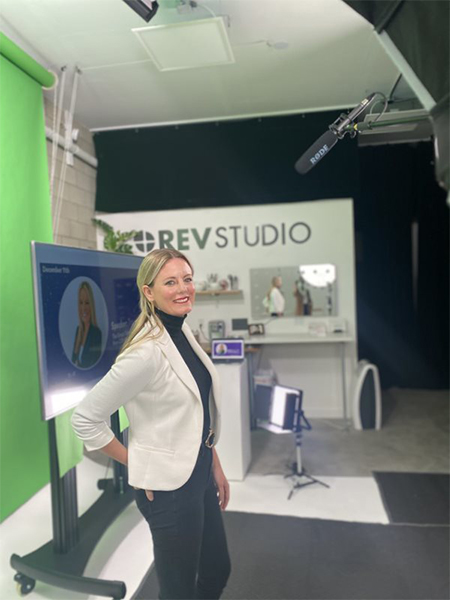How to Pull Off a Winning Virtual Studio Presentation

Tracy Judge, founder and chief connector of Soundings Connect, is as poised a person as you’ll ever meet. A former corporate meeting planner at Maritz Global Events, Judge runs her own company, a network for freelance event professionals, while contributing to many industry organizations and causes. She has an uncanny ability to build relationships and rise to any challenge, and is a popular speaker for events.
So, when Judge admits that the process of putting together a presentation in a virtual studio spooked her, it is noteworthy. “I had terrible anxiety,” she said of prepping for the 2020 Intrado Digital Media Summit in December. “I turned into a completely different person. I have not felt that scared or vulnerable in a long time.”
Such feelings are normal in the new world of meetings and events. Judge should be commended for admitting her fears. The point of her story is not that she was scared, it’s what follows.
While asking, “Why did I do this to myself?” in her head, Judge powered through the TedX-like talk on adapting to changes in the COVID-era. And as someone who encourages her employees and peers to step out of their comfort zones, Judge took her own advice and lived to tell about it.
“I felt really good I got through it,” said Judge, who used Rev Studio in La Jolla, California.
Nikkole Couture, Intrado’s vice president of go-to-market strategy who planned the December event, knows that a presenter's first venture into the digital studio realm can be daunting. “We don’t know we don’t know,” she said.
 While COVID-19 vaccines are being deployed, the days of virtual events are not behind us, Couture predicts. Health concerns and economic realities may cause many speakers and attendees to remain remote post-pandemic. Many hotels and convention centers are adding virtual studios to accommodate those needs.
While COVID-19 vaccines are being deployed, the days of virtual events are not behind us, Couture predicts. Health concerns and economic realities may cause many speakers and attendees to remain remote post-pandemic. Many hotels and convention centers are adding virtual studios to accommodate those needs.
With that in mind, we sought advice from Judge, the presenter, and Couture, the planner, about how to temper down fears and deliver a strong presentation when not face-to-face with a conference crowd.
Before the Show
1. Turn back your clock. Experienced speakers on the events circuit sometimes walk in 10 minutes before their time slot and hand over a memory stick to the planner. Most of the time, it works out fine in-person, despite the planner’s added stress. Couture says such turnarounds can’t and won’t cut it virtually. “A couple days before an event, I need to load the presentation into the platform,” said Couture, who threw Intrado’s staff for a loop with a similar request for its sales kickoff event. “I need to test it and make sure everything works.”
2. Find an audience. Couture wishes she were joking when noting that her cats and guitars have sat through many a dry run. But to be the cat’s meow to your audience, a speaker needs to find that perfect rhythm. And while you won’t be talking on a stage, that mindset needs to be there. What works? What doesn’t? Your cat might not be able to tell you, but honest team members definitely will.
3. Make a list. Always ambitious, Judge chose a new topic to make her return to speaking while entering a foreign environment to her. “We needed to have me prepared way ahead of time because it was new content and a new delivery method,” she said. As mentioned above, there’s nothing new about practicing a speech (though it must be done). But making the move from your home computer to a studio puts the onus on the presenter to ask what equipment is already provided. Do you need your own laptop? Are the HDMI and USB cords long enough? Do you need a TV monitor to watch your presentation? Many facilities in hotels and convention centers will have what you need, but ask ahead of time. For instance, Judge brought her own monitor with her, only to discover the studio already had what she needed.
4. On-Site Inspection. You’ve made your list, now check it twice with a practice session at the venue where you’re presenting. Keep in mind what color background you’ll be using (see below as to why) and get a general feel for the space. Stay until there is some familiarity—the last thing you want is for your audience to know it’s your first time in a virtual studio. “If I did it again, I could do it so much better now because I’d be more comfortable,” Judge says.
5. Tech check. The time in the studio is when you want to go over the presentation with the planner. Any experienced organizer like Couture will be able to offer good tips on anything from pacing to lighting, and also know how to explain the engagement features at your disposal. The planner should go over the platform with you, but don’t be afraid to ask questions for clarity or simply to practice. And don’t forget basics like checking for audio feedback!
Congratulations, you’re now ready to speak to a real-live virtual audience. Couture says now is the time to remember that speaking through a TV camera or computer is not the end of the world. “It’s not impossible, but it’s very different from the in-person experience,” she says.
The Day Of
6. Don’t ignore the technology. A speaker is going to want to be as natural as if he or she is on a stage in front of hundreds of people. Unfortunately, that is not going to be the case, so own it. “The chat is my favorite part as a presenter,” Couture says. “It’s where I see people interacting and firing off comments in real time. If the chat is dead, you’re not quite bringing it.” A first-timer may be gun-shy about reading such comments, but it’s best to pay attention. The most likely scenario is you’ll be getting encouraging feedback that will boost your confidence.
7. Dress wisely. There is a major practicality side to a speaker’s wardrobe. Remember when we mentioned noting the color of the background? If it’s white, don’t wear white or else “you’ll look like a floating head,” Couture warns. Bright colors, stripes and polk-a-dots tend to be distracting. Ditto for large earrings. Muted colors keep the focus on you, not your clothes. “Don’t take away from the main event,” Couture adds.
8. Have a teleprompter. Nerves can cause temporary amnesia. A teleprompter or monitor with slide cards is a great way to overcome forgetfulness.
9. Be prepared for anything. Judge was expecting to do a pre-recorded session—a little less stress-inducing—but a COVID-19 scare threw a wrench into those plans. Ultimately, the decision was made to go live. A challenge in its own right, broadcasting live meant Judge had to adapt mentally, arguably more difficult than the act of presenting. This is just one scenario in which an original plan can deviate. “You need to be flexible,” Judge says.
Ultimately, a speaker must remember to communicate. It’s not much different from preparing an email versus a video chat. There are benefits to all modes of communication, as long as you know what you are in for. “This stuff is not as hard as it looks,” Couture says. “Most of it is the exact same—we’re just going to accomplish it in a different way.”
Don’t miss any event-related news: Sign up for our weekly e-newsletter HERE and engage with us on Twitter, Facebook, LinkedIn and Instagram!


Add new comment